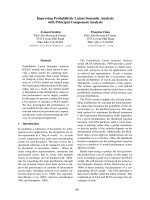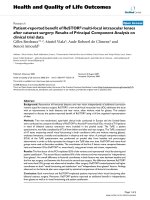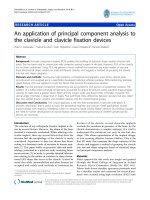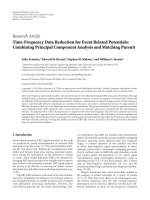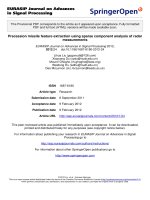Food grain production index using principal component analysis in Karnataka State, India
Bạn đang xem bản rút gọn của tài liệu. Xem và tải ngay bản đầy đủ của tài liệu tại đây (143.21 KB, 6 trang )
Int.J.Curr.Microbiol.App.Sci (2019) 8(1): 3138-3143
International Journal of Current Microbiology and Applied Sciences
ISSN: 2319-7706 Volume 8 Number 01 (2019)
Journal homepage:
Original Research Article
/>
Food Grain Production Index Using Principal Component
Analysis in Karnataka State, India
N.L. Pavithra*, K.V. Ashalatha, J. Megha, G.R. Manjunath and Siddu Hanabar
Department of Agricultural Statistics, College of Agriculture, UAS, Dharwad-580005,
Karnataka, India
*Corresponding author
ABSTRACT
Keywords
Composite Indicator,
Food grain production
index, Principal
component analysis
Article Info
Accepted:
26 December 2018
Available Online:
10 January 2019
Karnataka State has a typical composition having a large share of its area under highly
diversified agricultural crops, higher growth in agriculture assumes great importance and is
a matter of concern for policy planners and research scholars in recent times. A composite
index is a grouping of equities, indexes or other factors combined in a standardized way,
providing a useful statistical measure of overall food performance over time, and it is also
known simply as a "composite". Usually, a composite index has a large number of factors
that are averaged together to form a product representative of an overall food sector.
Indicators are useful for determining trends and drawing conclusions for particular issues
in policy analysis. They can also be helpful in making policy and in monitoring
performance. When several indicators are compiled into a single index using a specific
technique, then a composite indicator is formed. The composite indicator measures multidimensional concepts, which cannot be explained by a single indicator. Here, Food grain
Production Index (FgPI) has been constructed using Principal Component Analysis (PCA)
for 30 districts of Karnataka, India. In present study, the indicators like production of tur,
production of paddy, production of total pulses and production of total cereals have been
taken.
Introduction
Karnataka State has a typical composition of
having a large share of its area under severe
climatic constraints with a highly diversified
agricultural sector. Karnataka is the largest
producer of coarse cereals, coffee, raw silk
and tomatoes among the states in India. The
main crops grown here are rice, ragi, jowar,
maize, and pulses (Tur and gram) besides
oilseeds and number of cash crops. The state
of Karnataka is blessed with varied agro-
climatic conditions which permits the farmers
of the state to cultivate not only a variety of
crops in a season but also a number of crops
like cereals, pulses, oilseeds, commercial
crops and horticultural crops across different
seasons of the year. Agriculture in Karnataka
has occupied around 12.31 million hectares of
land, this comes to 64.6 per cent of the total
area. The state is one of the major producers
of paddy among all other states in India.
Karnataka has large rainfed areas next only to
Rajasthan as the future of agriculture growth
3138
Int.J.Curr.Microbiol.App.Sci (2019) 8(1): 3138-3143
in the state depends on this factor which
accounts for more than 75 per cent of the
cropped area. The share of agriculture in the
state GDP is around 16 per cent which is
higher than the current national average of all
the states in India. Karnataka is the state to
come up with a separate agriculture budget. In
this paper, Foodgrain Production Index (FgPI)
has been constructed using PCA with
production indicator for 30 districts of
Karnataka State, India.
Principal component analysis was used for
data reduction technique as well as for the
solution
of multicolinearity. Principal
component analysis was employed, with a
view to aggregate the performance indicators
into a few groups of factors. This technique
was used by many researchers for grouping
the factors and is the oldest and the best
known technique of multivariate analysis. The
principal components will be utilized in the
construction of composite index (Kumar et al.,
2013).
Materials and Methods
The data on food grain production has been
taken from the secondary source (Directorate
of Economics and Statistics, Govt. of
Karnataka, Bangalore and Karnataka at a
Glance: Government of Karnataka) for all the
30 districts of Karnataka for the year 2014-15.
District wise data on production of paddy,
production of pigeonpea, production of total
pulses and production of total cereals has been
analyzed. Principal Component Analysis
(PCA) is a statistical procedure that uses
an orthogonal transformation to convert a set
of observations of possibly correlated
variables into a set of values of linearly
uncorrelated variables called principal
components (or sometimes, principal modes of
variation).
The number of principal components is less
than or equal to the smaller of the number of
original variables or the number of
observations. This transformation is defined in
such a way that the first principal component
has the largest possible variance (that is,
accounts for as much of the variability in the
data as possible), and each succeeding
component in turn has the highest variance
possible under the constraint that it
is orthogonal to the preceding components.
The resulting vectors are an uncorrelated
orthogonal basis set. PCA is sensitive to the
relative scaling of the original variables.
Maximum Likelihood Estimate (M.L.E.) of
variance-covariance matrix (Σ) of the given
data set will be estimated by
… (i)
Where,
,
And n is total number of districts.
Then Correlation Matrix (CM) was obtained
using above variance-covariance matrix as
(ii)
Where,
V = Diagonal matrix obtained from variancecovariance matrix and
3139
Int.J.Curr.Microbiol.App.Sci (2019) 8(1): 3138-3143
= M. L.E. of variance-covariance matrix.
Let x1, x2...., are variables under study, then
first principal component may be defined as
z1 = a11x1 + a12x2 +.... + a1pxp
Such that variance of z1 is as large as possible
subject to the condition that
Where,
a11p2 + a12p2 +.... + a1kp2 = 1
Pqs: qth principal components
This constraint is introduced because if this is
not done, then Var (z1) could be increased
simply by multiplying any a1j’s by a constant
factor. The second principal component is
defined as
Zqs: standardized values of qth variable
akq: element belonging to kth eigenvector and
for qth variable,
Z2 = a12x1 + a22x2 +.... + a2pxp
k = 1,2, …,Q; q=1,2, …,Q.
Such that Var (z2) is as large as possible next
to Var (z1) subject to the constraint that
Now, the composite index will be constructed
using the obtained eigen values of variables
and principal components as under:
a12p2 + a22p2 +.... + a2kp2 = 1 and cov (z1, z2) =
0 and so on
It is quite likely that first few principal
components account for most of the variability
in the original data. If so, these few principal
components can then replace the initial p
variables in subsequent analysis, thus,
reducing the effective dimensionality of the
problem.
It is a mathematical technique, which does not
require user to specify the statistical model or
assumption about distribution of original
varieties. It may also be mentioned that
principal components are artificial variables
and often it is not possible to assign physical
meaning to them. Next step is to obtain
principal components using eigen vectors of
the estimated correlation matrix and
standardized values of variables. The principal
components will be obtained by using the
formula given below.
(iii)
Where,
CIi = Composite index for ith district
λjs are eigen values
Pqs = qth principal components, i=1,2, …,N;
j=1,2, …,Q.
Further, the composite index of each district
will be normalized by using the following
formula:
3140
(iv)
Int.J.Curr.Microbiol.App.Sci (2019) 8(1): 3138-3143
Where,
CINi = Normalized value of composite index
of ith district
min (CI) = Minimum value of composite
index
max (CI) = Maximum value of composite
index among all.
Variance Inflation Factor
Regression analysis was performed and
Variance Inflation Factor (VIF) for each
variable
was
obtained
to
detect
multicolinearity by regressing one variable to
other remaining variables. The Variance
Inflation Factor for jth variable can be obtained
as under
Where,
VIFj is Variance Inflation Factor for jth
variable and
Coefficients of determination (Rj2) will be
obtained by regressing jth variable on other
variable(s).
Results and Discussion
Correlation coefficient between production of
food grains in Karnataka state were calculated
which is presented in Table 1 in the form of
correlation matrix.
From the Table 1 it is clear that the total
cereals were highly significant and positively
correlated with paddy and pigeonpea was
significant and positively correlated with total
pulses for food grain production. Paddy was
negatively correlated and non-significant with
pigeonpea and total pulses and other variables
were non-significant. An attempt on
correlating the paddy was highly significant
and positively correlated with total cereals i.e.
correlation coefficient (r) was found out to be
1.00 (positively correlated) indicating that the
increase in production of paddy results in
significant increase in production of food
grains. Paddy is one of the major contributing
to totals cereals so there was a perfect
correlation between paddy and total cereals.
Pigeonpea was significant and positively
correlated with total pulses for food grain
production with a correlation coefficient
r=0.969. Other variables were non-significant.
In statistics, multicolinearity is a phenomenon
in which two or more predictor variable in the
regression model was highly correlated and it
affects calculations regarding individual
predictors. Variance Inflation Factor (VIF)
above 5 indicates multicolinearity.
The results of regression analysis along with
VIFs are given in Table 2. It was concluded
that the linear relationship among variables
were highly significant. It was also concluded
that the variable total cereals had serious
multicolinearity as VIF for total cereals were
greater than 10.
The variables paddy, pigeonpea and total
pulses showed very little multicolinearity.
Overall, it was concluded that there was
multicolinearity among variables. Thus, the
composite index was constructed using
principal component analysis to overcome the
problem of multicolinearity.
The composite indices of food grains
production was worked out for districts of
Karnataka state for the study period of 1990 to
2015. The districts were ranked on the basis of
composite indices. The composite indices for
food grains production along with the rank of
the districts were presented in the Table 3.
3141
Int.J.Curr.Microbiol.App.Sci (2019) 8(1): 3138-3143
Table.1 Correlation between food grains
Crops
Paddy
Total cereals
Pigeonpea
Total pulse
Note: ** significant at 1 %
Paddy
1.000
1.000**
-0.200
-0.121
Total cereals
1.000**
1.000
-0.200
-0.121
Pigeonpea
-0.200
-0.200
1.000
0.969**
Total pulse
-0.121
-0.121
0.969**
1.000
Table.2 Detection of multicolinearity
Model
1
2
3
4
Dependent
variable
Paddy
Total cereals
Pigeonpea
Total pulses
Independent variable
Total cereals, pigeonpea and total pulses
Pigeonpea, total pulses and paddy
Total pulses, total cereals and paddy
Pigeonpea, total cereals and paddy
Significant
value
<0.0001
<0.0001
<0.0001
<0.0001
R2 value
VIF
1.000
1.000
0.973
0.972
1.143
18.603
1.015
1.042
Table.3 Values of Composite Indices (C.I) of food grains production for different districts along
with the ranks
Districts
Raichur
Davangere
Bellary
Shivamoga
Mysore
Koppal
Mandya
Uttara Kannada
Hassan
Dakshina Kannada
Udupi
Belagavi
Haveri
Yadgiri
Chickmagalur
Kodagu
Chamarajanagara
Tumkur
Dharwad
Ramanagara
Chickballapur
Bangalore Urban
Bangalore Rural
Chitradurga
Gadag
Kolar
Bagalkot
Bidar
Vijayapura
Kalaburgi
CI
1.00
0.84
0.77
0.73
0.68
0.57
0.54
0.43
0.42
0.41
0.39
0.39
0.38
0.37
0.36
0.33
0.28
0.26
0.23
0.23
0.22
0.22
0.21
0.21
0.21
0.21
0.20
0.18
0.11
0.00
3142
Rank
1
2
3
4
5
6
7
8
9
10
11
12
13
14
15
16
17
18
19
20
21
22
23
24
25
26
27
28
29
30
Int.J.Curr.Microbiol.App.Sci (2019) 8(1): 3138-3143
During the study period, indicators based on
production of food grains, the district Raichur
was on the first position and the district
Kalaburgi was on the last position. The
composite indices varied from 0.0000 to
1.000. Four most food grains producing
districts were Raichur, Davangere, Bellary
and Shivamoga. Four least food grains
producing districts were Bagalkot, Bidar,
Vijayapura and Kalaburgi.
References
Anonymous, 2015, Annu. Rep. (2014-15).
Department of Planning, Programme
Monitoring and Statistics, Karnataka, p.
849.
Kannan, E., Kumar, P., Vishnu, K. and
Abraham, H., 2013, Assessment of pre
and post-harvest losses of rice and red
gram in Karnataka. Res. Rep., pp. 4652.
Kumar, M., Ahmad, T., Rai, A. and Sahoo, P.
M., 2013, Methodology for construction
of composite Index. Int. J. Agric. Stat.
Sci., 9(2): 639-647.
Nethravathi, A. P. and Yeledhalli, R. A.,
2016, Growth and instability in area,
production and productivity of different
crops in Bengaluru division. Int. J.
Agric. Environ. Biotechnol., 9(4): 599611.
Prem, N., Sharma, S. D., Rai, S. C. and
Bhatia, V. K., 2009, Inter-district
variation
of
socio-economic
development in Andhra Pradesh. J.
Indian Soc. Agric. Stat., 63(1): 35-42.
Pushpa, M. S., 2007, An econometric analysis
of demand and supply response of
pulses in India. Karnataka J. Agric.
Sci., 20(3): 545-550.
Sarawathi, P. A., Basavaraja, H., Kunnal, L.
B., Mahajanshetti, S. B. and Bhat, A. R.
S., 2012, Growth in area production and
productivity of major crops in
Karnataka. Karnataka J. Agric. Sci.,
25(4): 431-436.
How to cite this article:
Pavithra, N.L., K.V. Ashalatha, J. Megha, G.R. Manjunath and Siddu Hanabar. 2019. Food
Grain Production Index Using Principal Component Analysis in Karnataka State, India.
Int.J.Curr.Microbiol.App.Sci. 8(01): 3138-3143. doi: />
3143

